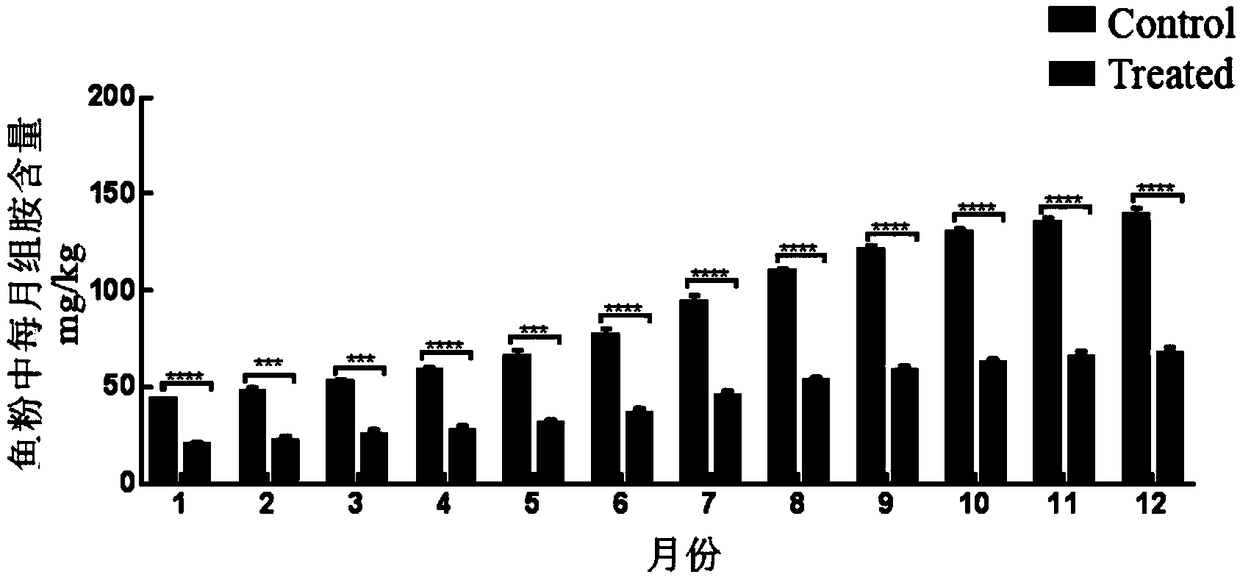PEG-ACS/M-siRNA nano-composite, application thereof, and method for reducing histamine content of fish meal in storage process
A PEG-ACS and nanocomposite technology, applied in the field of feed industry, can solve the problems of high cytotoxicity and in vivo toxicity, low efficiency, poor targeting, etc., and achieve the effect of wide application prospects and delaying the process of corruption
- Summary
- Abstract
- Description
- Claims
- Application Information
AI Technical Summary
Problems solved by technology
Method used
Image
Examples
Embodiment 1
[0057] (1) Design M-siRNA sequence.
[0058] Sense strand: 5'-GGAUCGUAUUUCUGUUGAAAU-3',
[0059] Antisense strand: 5'-UUCAACAGAAAUACGAUCCAC-3'.
[0060] (2) Preparation of M-siRNA.
[0061] (3) Preparation of ACS: Weigh 0.5 g of chitosan, dissolve it in a TEMED / HCl buffer solution with pH 5.0, then add 567 mg of EDC and 340 mg of NHS coupling agent to the solution, stir evenly, and then add the Arginine with 80% molar amount of polysaccharide amino group was reacted under magnetic stirring at room temperature for 8 hours, and then dialysis and freeze-drying of desalted water were carried out to obtain arginine-modified chitosan.
[0062] (4) Preparation of PEG-ACS: take 2.5 mL of 10 mg / mL arginine-modified chitosan, add 25 mg of PEG-SPA, and react at room temperature for 4 h. The unreacted PEG was removed by dialysis using a dialysis bag with a molecular weight cut-off of 14,000. The PEGylated arginine-modified chitosan is obtained, which is freeze-dried for later use.
...
Embodiment 2
[0075] (1) Design M-siRNA sequence.
[0076] Sense strand: 5'-GGAUCGUAUUUCUGUUGAAAU-3',
[0077] Antisense strand: 5'-UUCAACAGAAAUACGAUCCAC-3'.
[0078] (2) Preparation of M-siRNA.
[0079] (3) Preparation of ACS: 0.8 g of chitosan was weighed and dissolved in TEMED / HCl buffer solution with pH 4.5, then 900 mg of EDC and 550 mg of NHS coupling agent were added to the solution, and after stirring evenly, Arginine in equimolar amount of polysaccharide amino group was reacted at room temperature for 7 hours under magnetic stirring, and then arginine-modified chitosan was obtained by dialysis of desalinated water and freeze-drying.
[0080] (4) Preparation of PEG-ACS: Take 3 mL of 8 mg / mL arginine-modified chitosan, add 24 mg of PEG-SPA, and react at room temperature for 4 h. The unreacted PEG was removed by dialysis using a dialysis bag with a molecular weight cut-off of 14,000. The PEGylated arginine-modified chitosan is obtained, which is freeze-dried for later use.
[008...
PUM
| Property | Measurement | Unit |
|---|---|---|
| Particle size | aaaaa | aaaaa |
| Particle size | aaaaa | aaaaa |
| Particle size | aaaaa | aaaaa |
Abstract
Description
Claims
Application Information
 Login to View More
Login to View More - R&D
- Intellectual Property
- Life Sciences
- Materials
- Tech Scout
- Unparalleled Data Quality
- Higher Quality Content
- 60% Fewer Hallucinations
Browse by: Latest US Patents, China's latest patents, Technical Efficacy Thesaurus, Application Domain, Technology Topic, Popular Technical Reports.
© 2025 PatSnap. All rights reserved.Legal|Privacy policy|Modern Slavery Act Transparency Statement|Sitemap|About US| Contact US: help@patsnap.com



